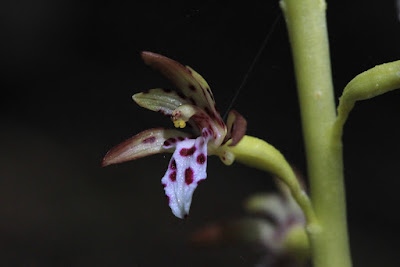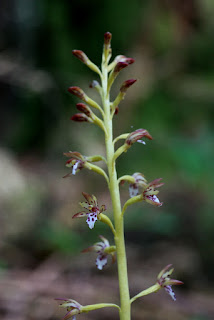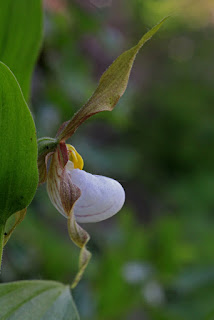Just one brief excursion this week to a trail in Mount Baker-Snoqualmie National Forest where I knew I could find the Early Coralroots, Corallorhiza trifida, blooming. I found the Western Spotted Coralroot, Corallorhiza maculata var. occidentalis, and the Western Coralroot, Corallorhiza mertensiana, as well and two Neottias, the Western Heart-leaved Twayblade, Neottia cordata var. nephrophylla, and the Northwestern Twayblade, Neottia banksiana or caurina.
The Early Coralroot, Corallorhiza trifida, is, all other things being equal, one of the earliest orchids to bloom in the spring, often blooming with the Fairy Slippers. But spring comes late in the mountains and the only sites I know for this species are in the mountains, so we are well into the native orchid season before we see these in bloom. It is a small plant, usually less than 30 cm with 1 cm flowers, the smallest and hardest to find of all the Coralroot species that grow in the area.
The Western Coralroot, Corallorhiza mertensiana, grows in abundance at a slightly lower elevation and in drier and darker areas and is found in its usual wide range of colors. I found it in colors that ranged from a deep pink through off-white and tan, and even some spikes that were pale yellow with nearly white flowers, not quite the alba form of the species but very close. It is always a delight to see this species in all its different color forms, and it seemed more abundant this year.
The Western Spotted Coralroots I found were just beginning to bloom and all seemed to be the brown stemmed form, Corallorhiza maculata var. occidentalis fma. intermedia. The plants were also very small, as were the flowers - not nearly so robust as others we had seen earlier in the year - but perhaps that has something to do with location and elevation. There were a few Coralroots with reddish stems that seemed more robust but they were not yet blooming.
The Western Heart-leaved Twayblade, Neottia cordata var. nephrophylla, was blooming in the same area as the Western Coralroots. This is a very common species and often carpets open and sunny areas, but was not nearly that abundant in this location. There is a reddish form of this species but I found only plants with green flowers. I had found it at lower elevations earlier in the season but it was already finished flowering and so I did not take photos.
I also found one plant of the Northwestern Twayblade, Neottias banksiana (old name: Listera caurina). A little later in the season, it, too, can be found along every trail in the area, but it was nice to see one plant blooming early. Like Listera cordata, it is a small plant with small flowers, the plants all less than 15 cm and the flowers around 1 cm in size, not plants that are quickly noticed, especially when one is looking for other things. I may, therefore, have missed some.
























































































